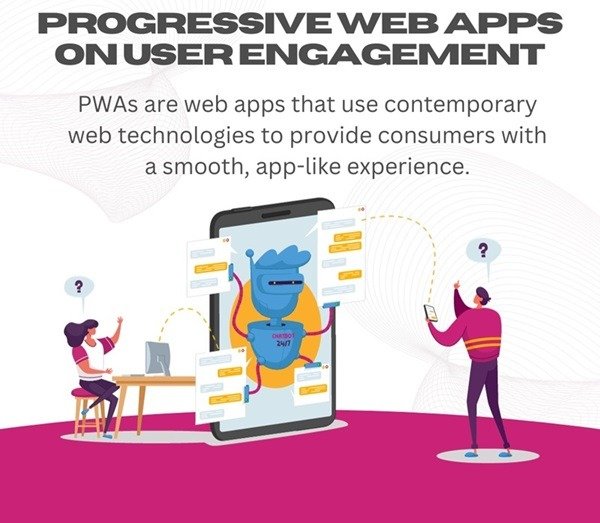The Impact of Progressive Web Apps on User Engagement
Frances Berriman and Alex Russell invented Progressive Web Apps (PWAs) in 2015. Service workers are used to allow features such as offline functioning and push notifications. PWAs gained speed in 2018. All thanks to universal browser support and increased recognition from big corporations. Microsoft’s support in 2019 was a big endorsement. PWAs continued to grow throughout the 2020s. It was because businesses were embracing technology to improve user experiences. The continual growth of web technologies points to a bright future for PWAs. This bridges the gap between web and native apps.

Progressive Web apps play an essential role in today’s digital world. They meet the need for a seamless and efficient user experience. They offer cross-platform compatibility, providing consistent performance across devices. PWAs thrive on offline functionality. Hence, it allows access to content even under unstable network settings. Their appeal stems from their low cost, ease of use, and ability to engage users through features like push alerts. PWAs also improve SEO. It emphasizes user trust and security. Not only this, it enables quick deployment and updates without user participation. PWAs suit current demands by being resource-efficient and adaptable to various connectivity conditions. These make them a viable solution for organizations and users alike.
Let’s have a detailed look at the impact of progressive web apps on user engagement. Before that, we have to be clear about progressive web apps and what’s going on in user engagement these days.
What are Progressive Web Apps:
Progressive web apps (PWAs) are an innovative way to develop a website. It combines the finest features of online and native mobile apps. PWAs are web apps that use contemporary web technologies to provide consumers with a smooth, app-like experience. They are intended to function on a variety of devices and platforms. These provide a consistent experience, independent of the user’s device or browser. Offline capabilities, timeliness, and the ability to be installed on a user’s device are some of the aspects of PWAs.
These qualities enable PWAs to run smoothly in poor network settings. It also adapts to multiple screen sizes. Moreover, PWAs replicate the performance and user experience of native applications. PWAs bridge the gap between online and native mobile applications. They provide a middle ground for native apps. They act as a middle ground for the discoverability and accessibility of the web through performance and engagement. It is accomplished through the use of technologies like service workers. This is something that provides offline functionality, push alerts, and increased speed. As a result, PWAs provide a compelling option for organizations and developers looking for a cost-effective solution.
The Current State of User Engagement
The present status of user involvement on online platforms is a significant component. It determines the success and longevity of websites and applications. The importance of user engagement cannot be overemphasized. It is a critical indicator for determining the efficacy of digital platforms. Actively engaged people are more likely to spend time on a website or app. They interact more with its features and contribute to its community. However, several obstacles remain to maintaining user interest.
Platforms can provide individualized information and suggestions. All thanks to personalization algorithms, predictive analytics, and machine learning. Gamification tactics, social features, and interactive aspects add to engaging user experiences. Responsive design and smooth navigation enhance user interfaces. It decreases friction and promotes extended contact.
Exploring the Impact of PWAs on User Engagement
● Faster loading times:
Progressive Web Apps (PWAs) transform the user experience by lowering loading speeds. It is faster than traditional web pages. PWAs’ effective caching algorithms allow them to load rapidly. It is possible, even on sluggish networks, to have a smooth experience. This is in sharp contrast to traditional websites. It frequently suffers from latency concerns. The higher speed of PWAs immediately correlates with better user satisfaction and retention rates. It is so because consumers are more willing to engage with a platform that provides quick and responsive performance.
● Offline Accessibility:
One of the primary qualities that distinguishes PWAs is their capacity to make content accessible. It is possible even when the device is not connected to the internet. PWAs use service workers to cache important resources. It allows users to view information before accessing it without an active internet connection. This capacity is crucial during periods of poor or no connectivity. It ensures that users may still interact with the app or website. Hence, keep high levels of user engagement.
● Push Notifications:
Push notifications are essential for re-engaging users, and PWAs excel at this. PWAs may offer timely and relevant updates to users even when the app is not open. They do it by utilizing push notification features. Effective PWAs showcase the value of push notifications. These are used by leading e-commerce and news platforms. These notifications inform users and encourage them to return to the app or website. It ultimately boosts overall user engagement.
● Responsive Design and Cross-Platform Compatibility:
PWAs promote responsive design, responding to different devices and screen sizes. This responsiveness guarantees an ideal user experience across all devices. These can be smartphones, tablets, or desktop computers. PWAs’ cross-platform compatibility reduces the need for separate development efforts for each platform. It speeds up the development process and lowers expenses. This versatility adds to a consistent and improved user experience. It makes PWAs an appealing alternative for organizations looking to reach a varied audience across many devices.
Case Studies:
Progressive Web applications (PWAs) have grown in popularity because they provide a consistent and engaging user experience across several devices. Here are a few examples of effective PWA implementations:
1. Twitter Lite:
Background: Twitter suffered from poor load times and low user engagement. It lagged, particularly in areas with slower internet connections.
PWA Implementation: To solve these challenges, Twitter launched Twitter Lite as a PWA. The PWA is intended to load fast even on sluggish networks. Hence, it provides offline capability and consumes less data.
Results: Twitter Lite increased user engagement and decreased bounce rates. It is particularly applicable in emerging areas with slower network connections.
2. Starbucks:
Background: Starbucks wanted to improve its consumers’ mobile ordering experience.
PWA Implementation: The Starbucks PWA allows users to explore the menu, personalize orders, and make payments. Offline access to previously seen menus and locations is also provided.
Results: The PWA resulted in a two-fold increase in daily active users. The PWA load time is substantially faster than the native app.
3. Flipkart:
Background: Flipkart is one of India’s major e-commerce platforms. It aimed to increase user retention and engagement on its mobile site.
PWA Implementation: Flipkart Lite was launched as a PWA to enable a quicker and more dependable shopping experience. It comes with features such as push alerts for discounts and offers.
Results: Following the debut of the PWA, Flipkart reported a 70% boost in conversions and a threefold increase in time spent on the site.
4. AliExpress:
Background: AliExpress wanted to target people in areas with sluggish network connections and limited storage capacity on their smartphones.
PWA Implementation: AliExpress adopted a PWA to give consumers a quick and dependable buying experience. It was applicable, especially on 2G networks. The PWA also allows users to add the app to their home screens without having to download it from an app store.
Results: AliExpress reported a 104% increase in conversion rates for new users and a 2x increase in pages visited per session.
5. Forbes:
Background: Forbes wants to boost user engagement and speed up their mobile site.
PWA Implementation: Forbes created a PWA with an emphasis on speed and offline access to content. Push alerts for breaking news are also included in the PWA.
Results: After releasing the PWA, Forbes observed a 43% increase in sessions per user and a 20% boost in ad viewability.
Conclusion
In a nutshell, Progressive Web Apps (PWAs) are the digital equivalent of superheroes. They save consumers from slow webpages and app weariness. PWAs combine the greatest features of websites and native applications with the speed of a caped crusader. Hence, it gives lightning-fast page loads and a wonderful user experience.
PWAs play the best role between people and technology. It offers offline capabilities, push alerts, and exceptional user engagement. So, here’s to PWAs, the unsung heroes that have transformed browsing into a fast-paced, exciting relationship! Cheers to a speedier, snappier digital future!





